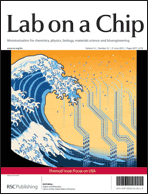From its original inspiration to its artwork, editors, authors, and highlighted discoveries, a recent special-themed issue of the journal Lab on a Chip has close ties to the Wyss. The issue — Lab on a Chip: the United States — focuses on America’s cutting-edge work in microsystems engineering. The topic was inspired by last year’s Wyss international symposium, “MICROFLUIDICS AND MEDICINE: Accelerating the flow from lab to clinic,” where leading researchers shared insights and approaches for translating technological discoveries into marketplace realities. In fact, the Lab on a Chip cover art is based on the original symposium poster.

Wyss Founding Director Donald Ingber, MD, Ph.D., and Core Faculty member George Whitesides, Ph.D., coauthored the introduction to the special issue and determined overall content selection with an eye toward exploring the ways in which microfluidic systems — in combination with cells — might lead to new solutions to critical issues in biomedical analysis. Microfluidics combines microfabrication, engineering, chemistry, and physics to design systems in which the behavior and manipulation of fluids are precisely controlled at the micro scale.
Ingber served as senior author on three other articles included in the issue, two of which related to new advances in microfluidics — a human gut-on-a-chip to test the safety and efficacy of new drug candidates and a device to capture rare circulating tumor cells for culture and analysis. The third article was an overview of organ-on-chip technology. Many Wyss coauthors contributed to these publications, as well. They were: Postdoctoral Fellows Hyun Mathumai Kanapathipillai, Joo Kang, Hyun Jung Kim, and Yu-suke Torisawa; Technology Development Fellow Dan Huh, and Senior Staff Scientist Geraldine Hamilton. Whitesides also coauthored an article on the use of a microfluidic device to perform chemical screens in toxicology and drug discovery program, and Associate Faculty member Ali Khademhosseini was the senior author on an overview of additional research advances in microfluidics.
Completing the list of Wyss contributors was Associate Faculty member David Weitz who served as senior author on two additional articles. One described a strategy for fabricating large quantities of microparticle structures and the other explored the use of droplet microfluidics to perform high-throughput screens and sensitive assays. Published by the Royal Society of Chemistry, Lab on a Chip is dedicated to miniaturization for chemistry, physics, biology, and bioengineering.